
In the “Copper Triangle” of Arizona, the Apache are fighting to protect their sacred land from mining giant Rio Tinto and Arizona Republicans. One major concern among the Apache community is that mining could contaminate the reservation’s aquifer.
San Carlos Apache Reservation, Arizona
In the parking lot of the grocery store on the reservation, we are introduced to Standing Fox, a local painter, hip-hop artist and activist amongst the Chiricahua Apache tribe, descendants of the warrior tribe who rode with Geronimo during the Apache Wars (1849-1906). They were the last tribe to fight against US military expansion in the United States.
The land exchange violates a 1955 executive order by President Eisenhower that explicitly puts the Oak Flat Campground land off limits to future mining activity.
My co-pilot, David, and I have traveled to Arizona from San Francisco to produce a short documentary. We decided to make the journey after noticing a provision – a congressional rider on the “must pass” National Defense Authorization Act – in which sacred Apache land would be quietly appropriated for a foreign mining interest. The use of a rider is a controversial legislative procedure in which provisions, unlikely to pass on their own, are added to a bill that has little to do with the rider. The provision, buried on page 1,103, was added largely thanks to the efforts of Sen. John McCain (R-Arizona) to the 1,648-page defense bill. The Oak Flat rider appeared on the bill little more than two days before voting was scheduled in Congress.
In Arizona, we are meeting with Vansler “Standing Fox” Nosie, Tribal Councilman Wendsler Nosie Sr. and Anthony Logan, also known as Rolling Fox, one of the tribe’s elder religious leaders. They represent part of the core group of Apache who are planning a 45-mile walk to their sacred Oak Flat, where they will stay in protest of the land grab.
Standing Fox
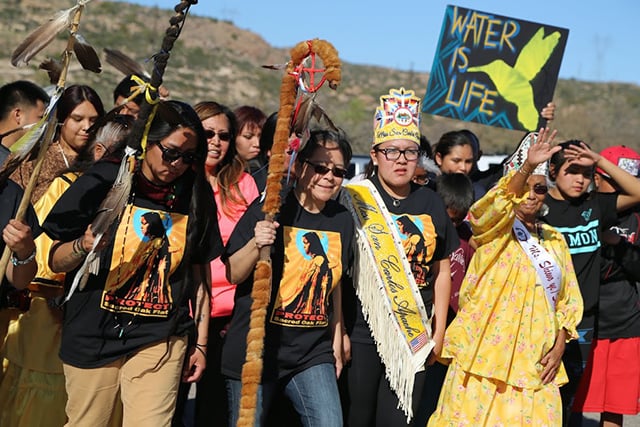 Women from the tribe lead the march into Oak Flat. (Photo: Roger Hill)
Women from the tribe lead the march into Oak Flat. (Photo: Roger Hill)
For years, Standing Fox and a dedicated core group of Apache activists have joined with a coalition of national tribes, environmentalists and concerned retired miners to oppose the land exchange transfer of the Oak Flat region to Resolution Copper, a subsidiary of Rio Tinto, a mining company headquartered in London. Over the past decade, Arizona Republicans have attempted unsuccessfully to pass the land exchange legislation – twice in 2013 failing to get enough votes to bring it to the floor of the House of Representatives. The land exchange also violates a 1955 executive order by President Eisenhower that explicitly puts the Oak Flat Campground land off limits to future mining activity.
Standing Fox joins us in the car to give us a quick tour of San Carlos. We don’t make it far, as just beyond the parking lot is a water tower with a mural of an Apache woman and the tribe’s sacred four crosses. Standing Fox informs us he was one of three artists that created the mural. We take a quick detour to have a look. Painted on the mural are the words “Water is Life” written in the Apache language.
“Water is life. We have to protect what we have, and we have to protect our water.”
Standing Fox walks towards the water tower and says, “We’re not too far from Oak Flat, from the rez line where we have our water aquifer.” The prospect of the mining contaminating the reservation’s aquifer is a major concern among the Apache. Resolution Copper’s proposal plans for a form of mining called block cave mining. This process involves a series of deep underground detonations, essentially collapsing the mountainous terrain in on itself and extracting the ore and materials from a series of tunnels dug in the earth. This process creates more toxic material than traditional surface mining and produces greater contaminants affecting the groundwater with acid runoff.
“When this happens, block cave mining, it is directly going to affect our water aquifer,” says Standing Fox, standing before the blue mural. “So we’re trying to tell outside towns, you know the border towns, ‘hey, if this happens where are you going to get your water from?'”
The neighboring mining towns of Miami and Globe receive their water from the Apache Reservation aquifer. The Apache report many hostile attitudes from the predominantly white populations of Globe and Miami, however, construction of the Oak Flat mine puts both those communities at risk of water contamination.
“Coming back to this water tank, this is the whole message,” Standing Fox says. “Water is life. We have to protect what we have, and we have to protect our water.” We then get in the car to drive to Old San Carlos where the Apache were imprisoned during the Apache Wars by the US military.
Old San Carlos
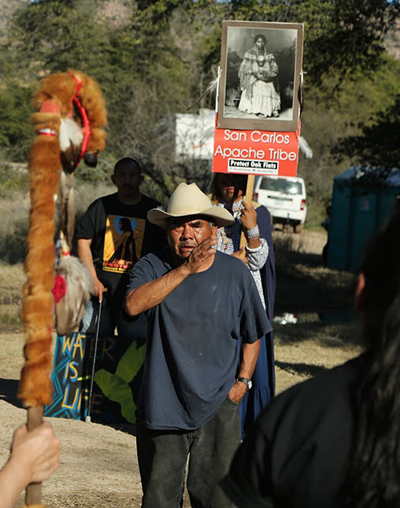 Anthony Logan, “Rolling Fox” leads a religious ceremony upon arrival to Oak Flat. (Photo: Roger Hill)
Anthony Logan, “Rolling Fox” leads a religious ceremony upon arrival to Oak Flat. (Photo: Roger Hill)
Red mud begins to coat the wheelhouse of our rental car. A wild horse stares at us as we drive down the remote dirt road toward the Old San Carlos Memorial. Standing Fox looks out the window as we make our approach. “Where we are heading to now is Old San Carlos, where they first put our people as prisoners of war,” he says.
The Old San Carlos Reservation was in essence a prison camp for Apache and other native tribes in the area, commonly referred to as “Hell’s 40 acres” by the US soldiers stationed at the fort on the reservation. Old San Carlos was a desolate, hot and dry environment that was not hospitable to the Apache way of life. A US Cavalry officer stationed there from 1883 to 1884 wrote in his memoirs about Old San Carlos: “In the summer a temperature of 110 degrees in the shade was cool weather. All other times of the year flies, gnats and unnamable bugs swarmed in the millions.”
The Apache tribes were largely confined on this reservation from about 1872 to 1929. In addition, thousands of Chiricahua Apaches were shipped in windowless railcars as prisoners of war to reservations in Florida and later Oklahoma; many did not survive the journeys.
“We’re still prisoners of war today.”
We step out of the car and continue on foot. The memorial to Old San Carlos is approached with great reverence. “When we first started seeing them coming, our Indian people saw them blasting in the hills over there,” Standing Fox says. He points to the crimson mountains beyond the valley of Old San Carlos. “And we found out what they were doing. It was for gold and copper, and we knew that it was bad. So what did we do, we fought against this invasion of them taking over this land, but also protecting who we are as a culture.”
We stand in a vast valley surrounded by mountains. The monument stands on higher ground than the flooded lowlands of the old reservation. In 1929, the Coolidge dam was built, submerging this area in water. Much of the water has since evaporated, revealing remnants of the structures that stood near the military fort in Old San Carlos, including foxholes where US military snipers would assassinate Apaches attempting to cross the reservation line.
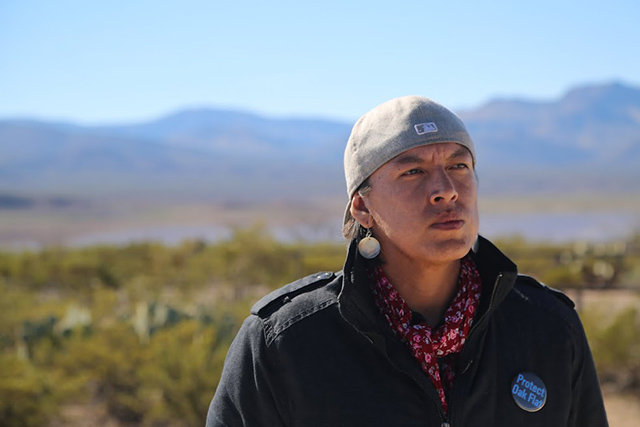 Vansler Nosie, “Standing Fox” reflects on the grounds of Old San Carlos, where Apache were held as prisoners of war by the US military. (Photo: Roger Hill)
Vansler Nosie, “Standing Fox” reflects on the grounds of Old San Carlos, where Apache were held as prisoners of war by the US military. (Photo: Roger Hill)
When asked about the history of his people as prisoners of war, Standing Fox states bluntly, “We’re still prisoners of war today.” Relating this to the land exchange provision, he says, “It was really a slap in the face when John McCain threw it into a defense bill…. Using the defense bill really is a slap in the face to Apache people. I believe they’re making a statement, and it should anger people.”
Arguably, some Arizona Republicans share Standing Fox’s assertion that the Apache are still prisoners of war. A recent statement by Arizona Rep. Paul Gosar has particularly incensed the Apache people. When pressed by Phil Stago of the White Mountain Apache Tribe about the Oak Flat land exchange violating Apache sovereignty, Gosar replied, “You’re still wards of the state.”
We sit quietly, reflective, as we slowly navigate the dirt road out of San Carlos. The next day, Standing Fox will join his fellow Apache activists in protest, by marching from the reservation town of San Carlos to their sacred land of Oak Flat.
“There’s Never Anything Given Back”
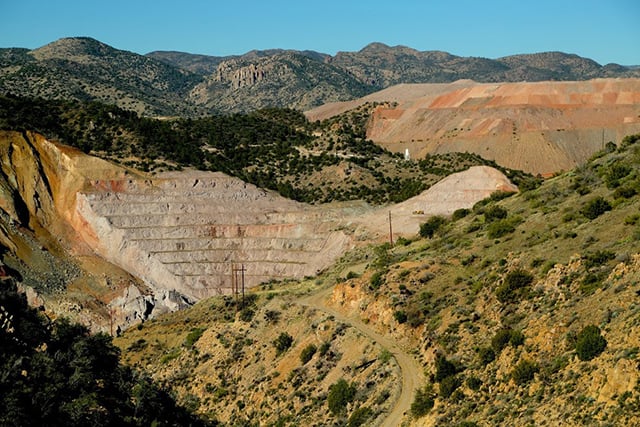 An open pit copper mine on the side of the highway on the journey to Oak Flat. (Photo: Roger Hill)
An open pit copper mine on the side of the highway on the journey to Oak Flat. (Photo: Roger Hill)
The next morning, 15-year-old Naelyn Pike sits on the floor of her grandfather Wendsler Nosie Sr.’s home, lacing up her moccasins. It’s just after 7 am and Naelyn has resolved to start the walk from San Carlos in her traditional footwear.
Naelyn has been raised within the movement to save Oak Flat, attending rallies since the age of 2. At 15, she has already testified before US Congress, and is a respected young leader of the Save Oak Flat movement. Naelyn speaks about Oak Flat with great passion. “We are the people to protect Oak Flat; we as Apache people, we protect Mother Earth and this is what we are going to do; that’s why we’ve taken this bold step,” she says. The challenge for Naelyn will be to walk the whole way, and resist the urge to run to Oak Flat.
“As far as all these parcels that were taken, the tribe never benefitted once from it; there’s no tax dollars returned or huge employment; there’s never anything given back.”
Naelyn’s grandfather, Wendsler Nosie Sr., arrives and lays some maps on the table. The maps depict the history of land appropriation from the Apache Reservation by the federal government: Apache land has decreased dramatically. Wendsler points to the copper-rich Oak Flat parcel taken from the historic Apache Reservation in 1902. “As far as all these parcels that were taken, the tribe never benefitted once from it; there’s no tax dollars returned or huge employment; there’s never anything given back.” The unemployment rate on the San Carlos Apache Reservation stands at a staggering 70 percent.
 This water tank on the Apache Reservation serves as a reminder of the importance of clean water. (Photo: Roger Hill)
This water tank on the Apache Reservation serves as a reminder of the importance of clean water. (Photo: Roger Hill)
Oak Flat is just beyond the reservation line in the Tonto National Forest. While the Apache have legitimate claim to the land as part of their traditional homeland, they are not demanding Oak Flat be returned to the Apache Reservation. Their demands are simply that it not be mined, and remain a public park they can visit to perform their rituals and gather acorns and herbs, important elements of their traditional way of life.
About a hundred people gather at the administration building in San Carlos. The march is soon to begin. After a couple of speeches and a traditional dance, marchers pose for a few pictures and begin the 45-mile walk to Oak Flat.
The March to Oak Flat Begins
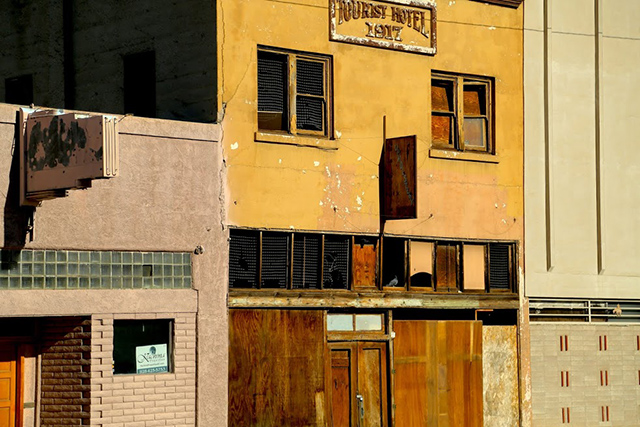 This long abandoned hotel in downtown Miami Arizona serves as a reminder of the boom or bust nature of the mining economy. (Photo: Roger Hill)
This long abandoned hotel in downtown Miami Arizona serves as a reminder of the boom or bust nature of the mining economy. (Photo: Roger Hill)
There is a lot of energy as approximately 100 marchers leave the town of San Carlos. The first 12 miles of the journey are flat, on reservation land, and the sun is bright but not oppressively hot. Supporters pass out water and granola bars. Wendsler and Standing Fox are in the front of the march. Behind them, Naelyn is carrying a sign with a picture of a bird and the tribe’s four sacred crosses. “It’s not just us that are here – our ancestors, those that fought for us – those generations are here,” she says. “They are fighting with us. I can feel their presence; they’re walking with us.” Naelyn radiates excitement.
Young children cheer and wave from behind a chain-link fence outside their preschool; a teenage boy hoots in excitement from the dirt yard of his small home; an elderly woman sits on her porch clapping. The sun begins to hang low in the sky as the march approaches the reservation line. Fatigue begins to set in.
On the reservation line, I snap a picture of Naelyn standing in the light of the setting sun: She is full of resolve. Marchers individually pass through the sacred staffs. A prayer is recited and the walk continues toward Globe, away from the tribe’s jurisdiction.
In Arizona, tax revenue from the mines is split based on population, so the small towns that bear the brunt of the industry see far fewer tax dollars than high population areas removed from the impacts of mining, such as Phoenix or Tucson.
“Being at the reservation line, right here is the point where we say we are healed; we no longer have the disease [of fear] and we are fighting back,” Naelyn says. “All of that fear that the US government – that the cavalry – have put on us, all of that is gone. It’s no longer on our shoulders. Once we cross this line, we’re in the fight; we’re in the forefront.” The Apache marchers form a tighter line as they walk along the highway toward Globe.
A pickup truck drives by; the passenger yells, “Get a job!” at Naelyn and the other marchers. Not a particularly creative insult, it garners an eye roll at best. It is dark and the walk has been going for more than 10 hours. In the cover of night, the marchers walk under a streetlight, past a gun store, Globe Gun and Pawn. Ahead is the steepest hill on the first day of the walk. Everyone is exhausted.
On the other side of the hill is a dirt parking lot where the Apache will be sleeping this night. It’s not an ideal campsite, but it was the only place in Globe they found permission to camp, from the private owner of the lot. Apache painter and activist Carrie “CC” Reede Curley musters the strength to jog the first sacred staff across the finish line. Dinner is served; tents are pitched. Tomorrow, an even greater challenge awaits.
The March to Oak Flat, Day Two
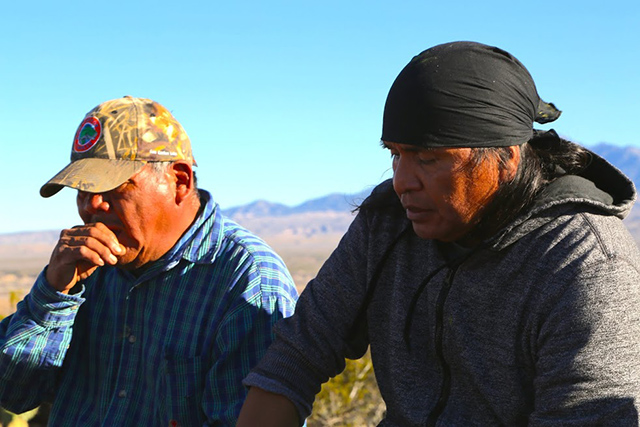 Wendsler Nosie Sr. and other Apache leaders prepare for the journey to Oak Flat by singing religious songs at Old San Carlos. (Roger Hill)
Wendsler Nosie Sr. and other Apache leaders prepare for the journey to Oak Flat by singing religious songs at Old San Carlos. (Roger Hill)
The next morning, the campers gather together and prepare to depart. Wendsler is reenergized. “Today, we start climbing the mountains … and it gets exciting, because we’re nearing the holy place.” Soon after departing, the march reaches the impoverished mining town of Miami.
There are signs of mining everywhere: On the hilltop is a processing plant with a train pulling in and out, carrying copper ore and other material. In the town center stands a boarded-up two-story building that reads “Tourist Hotel 1917.” The windows of the old hotel are broken; pigeons fly in and out of the decaying structure; it stands as a reminder of the boom or bust nature of the economy of mining towns.
In Arizona, tax revenue from the mines is split based on population, so the small towns that bear the brunt of the industry see far fewer tax dollars than high population areas removed from the impacts of mining, such as Phoenix or Tucson. Increasing the economic hardships in these towns, new automated mining techniques mean fewer miners than in the past.
As the march reaches a small shrine on the side of the highway just past the city limits of Miami, Wendsler addresses the crowd. “I am so proud coming through Globe and Miami … the Mexican lady I just talked to said she just found out the road’s being rerouted, and she said, ‘I’ve been praying for you guys and I’m with you.'” The economy of Miami, Arizona, is further threatened by plans to reroute Highway 60 away from the town, to accommodate the proposed Oak Flat development.
The march has now reached a stretch of highway that is mountainous and dangerous for pedestrians. Young volunteers raise their hands to take turns carrying the ceremonial staffs, while the others load into vans for the final few miles. David and I park our rental car a mile ahead of the young runners. We are in the Pinal Mountains, near a trailer park named Top of the World. On the horizon is an enormous open-pit copper mine. Below is a busy bridge, hundreds, maybe a thousand feet in the air. A lone jogger, Naelyn, approaches the bridge with a ceremonial staff in each hand. She strides with purpose across the highway bridge near Top of the World.
Oak Flat
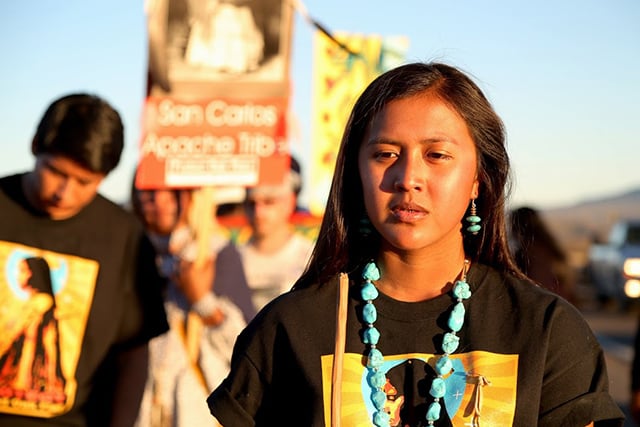 Naelyn Pike stands at the reservation line leaving the San Carlos Apache Reservation. (Photo: Roger Hill)
Naelyn Pike stands at the reservation line leaving the San Carlos Apache Reservation. (Photo: Roger Hill)
One by one, young people from the tribe take turns jogging the staffs the final miles to Oak Flat. Hundreds have gathered at the entrance to the campground in anticipation. Naelyn happens to be the final runner bringing in the sacred staffs to Oak Flat. She reaches the finish line; tears of joy roll down her face. The crowd cheers as Naelyn runs into her grandfather’s open arms. Wendsler Nosie Sr. beams with pride. “This little girl has what it takes,” he says. “She will be witnessing a lot of things that are not right, if we don’t better it, if we don’t stand up. And to see those emotional tears coming out of her while being strong. I think, while she was finishing and bringing in the staff, she was really crying for the rest of us.”
“Our religion is deeply rooted in these sacred places and it’s what our ancestors fought for and died for … as young people we honor them today, standing up for what is right and protecting our religion and our way of life, our Apache way.”
Indigenous and environmental activists from around the country have swelled the campsite. Rolling Fox leads the various tribal nations in a series of prayers. After the ceremony, Standing Fox, exhausted, rests near a creek and reflects on Oak Flat. He’s been fighting laryngitis throughout the march and these are the first words we’ve heard from him in the past two days. “Our religion is deeply rooted in these sacred places and it’s what our ancestors fought for and died for,” he says. “And as young people we honor them today, standing up for what is right and protecting our religion and our way of life, our Apache way.” Like his ancestors before him, Standing Fox will treat his cold with the herbs that grow in Oak Flat.
The next day, most of the visitors have left Oak Flat. Remaining is the core group of Apache activists whom David and I met in the grocery store parking lot on the reservation. They are joined by a few other dedicated activists determined to occupy Oak Flat until they are forced to leave, or until the development plans for Oak Flat are scrapped or rescinded.
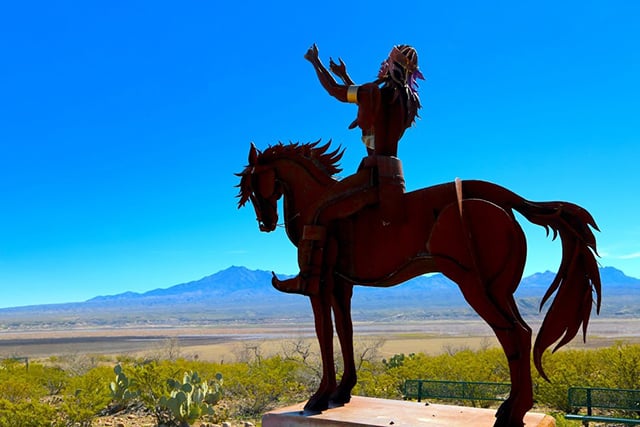 A statue of an Apache warrior reaching to the heavens stands at the memorial to Old San Carlos The valley beyond the statue is where Apache’s endured as prisoners of war. (Photo: Roger Hill)
A statue of an Apache warrior reaching to the heavens stands at the memorial to Old San Carlos The valley beyond the statue is where Apache’s endured as prisoners of war. (Photo: Roger Hill)
Our little rental car is full of trash, coffee cups, bottles of water; it is caked in mud inside and out. The smooth streets, golf course and gated community we drive past on our return to the Phoenix airport feel like a world away from San Carlos, Globe, Miami, Top of the World and Oak Flat. Our ride, minus the mud, fits right in. Out of sight, out of mind.
For Arizona Republicans, it is easy to give away something that does not belong to them: just sneak it into a defense bill. It is much more difficult to hold on to someplace sacred, to protect it from destruction and save holy land for future generations of Apache warriors. In the “white man’s world,” as we heard many times over recent days, it is much harder to preserve than to develop.
Despite the great imbalance of power, the Apache are staying put and the fight for Oak Flat continues.
Roger Hill worked with documentary filmmaker David Zlutnick at Upheavel Productions on this report.
Join us in defending the truth before it’s too late
The future of independent journalism is uncertain, and the consequences of losing it are too grave to ignore. To ensure Truthout remains safe, strong, and free, we need to raise $43,000 in the next 6 days. Every dollar raised goes directly toward the costs of producing news you can trust.
Please give what you can — because by supporting us with a tax-deductible donation, you’re not just preserving a source of news, you’re helping to safeguard what’s left of our democracy.